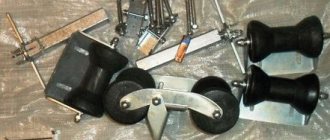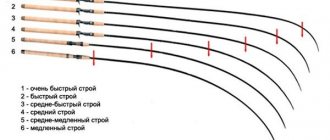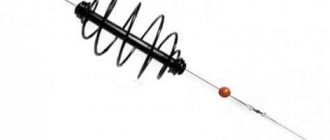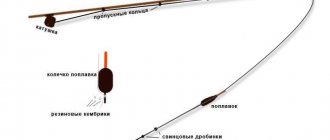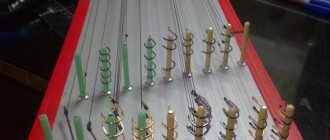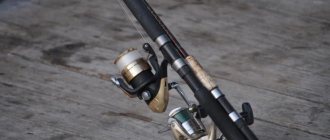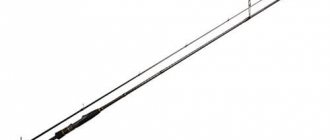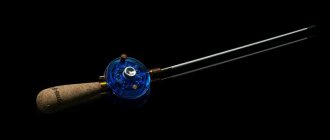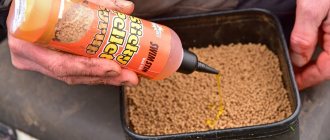Tube manufacturing process
We measure the size of the spinning rod, taking into account that 2 cm of foam rubber will be glued to the plugs on each side. We add another 4 cm to the measurements. An ordinary plastic pipe will do, on which you need to mark the length of the gear, and saw off the unnecessary remainder with a hacksaw.
The sawn-off part will be closed “tightly” with a plug, while the other side will be equipped with a removable lid. After these steps, a butt ring is placed in the pipe, which should move freely along the entire length.
At the next stage, we make a cover for the case and make several small holes in it to sew on the foam rubber. You can use a sponge for this. At the final stage of work, we give the tube the proper appearance - we cover it with fabric.
As a result, you will get a tube for your spinning rods, which you make yourself, and will be even better than the analogues sold.
Necessary available materials
Perhaps you still have unnecessary pipes after repairs. If not, this accessory can be found at a hardware store. Finding another suitable material is also simple; similar profiles that have the required stiffness parameter will do.
It is also necessary to additionally purchase plugs for plastic pipes. You will also need foam rubber to prevent damage to the rods inside the case. It is not necessary to buy a whole sheet of foam; you can use a sponge or washcloth.
The design of a hard case for a fishing rod can be done in various ways, which we will discuss below.
Cover for case
To transport fishing rods, you need to equip the tube with a lid. A thick layer of leather can be used. It is necessary to measure the diameter of the plastic profile and add 3 mm to it. We cut out a circle of leather of this size. A slightly larger size will not allow the lid to fall inside the profile. We also cut out several more similar parts from leather, but this time they should be 1.5 mm smaller than the diameter of the tube.
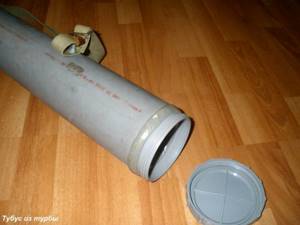
All that remains is to glue the leather parts together. The lower part of the lid will fit tightly into the plastic pipe, and the larger upper element will prevent it from falling inside. The covers, which are made of leather, are practical.
Making a tube from a pipe
First you need to decide how many fishing rods will be in the case. If there are several, in this case we choose a pipe with a diameter of 110 mm. If a cover is needed for one fishing rod, we purchase a pipe from 40 to 60 mm.

The tube produced must fully match the length of the rods. The simplest version of a pipe cover is made in several steps:
- Having measured the entire length of the rod, we saw off the pipe.
- We purchase plugs and put them on the structure.
All this will take less than 20 minutes. We first glue the plugs on the inside with foam rubber; for this you can use PVA glue, superglue or moment. It is best to glue one plug to the base of the structure.
Necessary materials
Before starting work, you must ensure that you have the following materials:
- PVC tube (average length up to 2 meters, diameter from 40 to 110 mm);
- a simple pencil or marker;
- meter or ruler;
- a piece of fabric that will cover the tube;
- several pieces of foam rubber;
- hacksaw for metal;
- several plugs;
- glue.
Blueprints
Before you start assembling a homemade gear case, you need to think through the plan in more detail and complete the drawings. Before starting work, it is worth considering how many spinning rods will be stored in the case, what material it will be made of and whether it will eventually be covered with fabric.
The drawing must indicate all the necessary dimensions of the future structure, taking into account the length of the rods. If the calculations are incorrect, all subsequent work will not be effective, so it is better to check everything and calculate it several times.
PVC pipe 50 mm
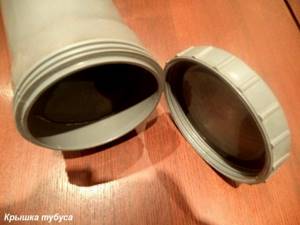
To make a tube version for storing one fishing rod, you need to buy a sewer pipe with a diameter of 50 mm. This will be ideal. If we consider a larger diameter, then it will be suitable for several spinning rods.
Required tube materials:
- pipe 50 mm (you must first measure the required length in accordance with the parameters of the rod);
- two plugs;
- fabric for covering;
- foam;
- glue.
If desired, one side of the tube can be sealed. To do this, first apply adhesive to the plug and secure it. Fishing rods must match the size of the tube. When sawing off the pipe, add 2 cm on each side, since the foam rubber will be attached - this is very important.
DIY hard case for fishing rods
Often, when fishing for a longer period, it becomes necessary to take several fishing rods with you, which can become tangled, broken or dirty when moving. This issue is solved with the help of a rigid tube, which can be made quite easily and quickly, for example, from a polyvinyl chloride water pipe.
The strap for such a product can be taken from an old bag, threaded through pre-drilled holes along the edges of the tube or tightly wrapped around the pipe. To improve the appearance, we use self-adhesive film , which will give the product individuality and reflect the tastes of the owner.
Necessary materials
To make a hard tube you will need materials and equipment, most of which can be found at home or hardware stores:
- The plumbing pipe is 15-17 cm longer than the folded fishing rod, which has a diameter of approximately 50 cm, so that the tackle with all the rings and reel fits into it. If the reels are removable, it is possible to place several fishing rods in the tube.
- A piece of ordinary plastic;
- A piece of sheet plastic 5-6 cm wide;
- Clear tape;
- Masking tape;
- Paralon of small or medium thickness;
- Industrial dryer;
- Board for processing;
- Glue gun stick.
Putting the fishing rod on a flat table made of dense wood, we measure it in the assembled state, the length ranges from approximately 1.1 meters to 1.6 meters. The pipe is then heated with an industrial hair dryer until the plastic becomes soft.
We press down the pipe with a slightly longer board, making it oval so that the rod rings fit freely. Let it cool and make the bottom of the tube.
To do this, take a plastic circle with a diameter equal to the diameter of the plumbing pipe, heat it together with the end of the pipe and connect it by wrapping the plastic circle around the hot edges of the pipe. After cooling, we get a ready-made convenient and practical tube.
You can also use a plug by purchasing one from a plumbing supply store and attaching it with super glue.
Take a look at another article on the site and find out how to make your own fishing chairs.
Making a tube cap
The tube cap is also made from a piece of plastic. To do this, take a circle with a slightly larger diameter than the pipe, about 0.5 cm , bend it around with sheet plastic and glue it with a glue gun.
You can also use a plug, just without gluing it as in the first case, since it must be removable. In order not to lose the lid, you should drill a small hole in it through which to stretch a rope with a small knot at the end and secure it inside the tube using super glue
The lid and the tube itself can be glued with thin foam rubber to soften the impact of the fishing rods on the walls when moving in order to avoid the slightest damage, since even microcracks will eventually lead to breakage, deterioration in appearance and premature wear of the fishing rod.
How to make a cover for a fishing rod?
You can do it simply and purchase a plug for a plastic pipe, which will serve as a cover for the cover. If for some reason there is no plug and it is impossible to get it out, you can make a lid from improvised materials. Cut a circle out of leather.
The diameter of such a part should be 1.5 mm larger than the tube itself. We cut out the second circle so that its diameter is 1 mm smaller than the tube. All that remains is to glue these two elements and put the lid on the case. To make a lid, you can use not only leather; felt or other dense material is also suitable.
It is also worthwhile to “tightly” attach the lid to one side of the case; for these purposes we use an adhesive substance.
DIY soft case for fishing rods
To make a soft case for fishing rods, the following materials are needed:
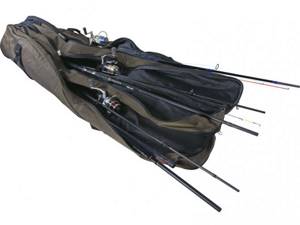
- Waterproof fabric such as bologna or tarpaulin of any color, 2 meters long;
- 2 meters of adhesive dublerin;
- 1.5 meter long zipper for the main fastener;
- 2 or 3 zippers 30-40 centimeters long for pockets;
- 2.5 meters of grosgrain ribbon;
- Velcro;
- Thick threads;
- Scissors;
- Sewing machine and iron.
Step-by-step sewing instructions
Having the slightest sewing or DIY skills, as well as simple equipment, you can, using step-by-step instructions, easily make a soft case for your fishing rod.
Step-by-step sewing instructions:
- We cut out the cover by folding the fabric in half and making marks at a distance of approximately 12 cm and 23 cm from the fold along the edges. We connect the marks with a straight line. The length of the cover will be approximately 1.5 meters. The size and shape can be changed as desired, for example, made rectangular. It is beneficial to sew two covers at the same time, since the width of the fabric allows you to make a similar layout with minimal waste.
- on the whole canvas of dublerin and duplicate it using a hot iron. We cut out the glued parts with scissors. To be on the safe side, you can stitch the parts of the top connected to the dublerin so that it does not come off during processing.
- From the remnants of bolognese fabric, we cut out pockets of the desired size and duplicate them with an iron, using adhesive dublerin. The number of pockets can be from two to four; they are made for convenience with a zipper or Velcro, the most commonly used size is 35 by 35 centimeters. First, we sew a zipper along the edge of the pocket, making fastenings at the ends, then we adjust it onto the cover itself according to the basting. Pockets must be sewn on at the bottom in the wider part of the cover. In order for the pockets to be spacious, a fold is placed on the side, which is stitched at the bottom. First of all, the lower part of the pocket is adjusted, then the sides.
- To make it easier to transport the cover, we make two thick handles, which we sew with strong threads through the entire product. To seal, we use corsage tape or make handles directly from it. The handles should go through the bottom for greater strength of the product.
- At the end of the work, sew on a long zipper , starting from the narrow part and ending with the wide one. If the zipper is slightly shorter than the cover, we stitch the rest of the part on the machine from the inside, and also process the bottom. Turn the cover right side out. For fastening, you can use two zippers stitched towards each other, which will provide additional ease of use of the product.
- The case can be decorated with finishing details , emphasizing the individuality of the owner. For example, embroidering initials or your favorite type of fish with ribbons. Perhaps use an applique purchased in a store, as well as a keychain or soft toy, hanging them on the zipper slider.
- We place convenient boxes in the pockets and put various little things there: containers with bait, floats, hooks and much more.
In this case, due to the simplicity of the cut, there is no need to make a paper pattern; you can cut it directly on the fabric, which will significantly save manufacturing time. You also need to have some sewing skills or be smart.
Additional recommendations
It is important to have a cover for a fishing rod with a reel, since it is not always convenient and possible to remove the reel, and it is often expensive and quite in need of protection from damage, and contamination can significantly deteriorate the quality of its work or ruin it completely.
When sewing a cover for a fishing rod and reel, you need to take into account some features:
- We cut and duplicate the fabric as for sewing a soft cover.
- But in this case it is necessary to make an additional compartment for the coil . To do this, take a piece of fabric corresponding to the width and height of the spool, duplicate it and sew it to the main parts at the height of the spool.
- We take a longer zipper for the fastener to take into account the bulges of the compartment for the reel.
To sew the cover we use high-quality dense threads, then it will last much longer and will be very reliable and strong, which is very important in order to avoid unpleasant surprises when arriving at the fishing spot.
Tube design
You can attach a handle to the case to make it comfortable to carry; you can also cover it with fabric or decorate it with rivets. Get creative and design your case to suit your preferences and it will attract the attention of other anglers.
How to cover a tube with fabric?
For these purposes, it is better to choose fabrics that are not too dense in structure, so it will be much easier to work with. The stretchy and elastic fabric will fit perfectly on the hard cover, and if necessary, it can be removed and washed.
It is necessary to sew a cover from an elastic material that will be a couple of millimeters smaller than the tube. To do this, you should first prepare a pattern and mark it with chalk. The lower part of the cover is sewn with strong threads in a straight line, only then a side seam is made, which runs perpendicular to the bottom.
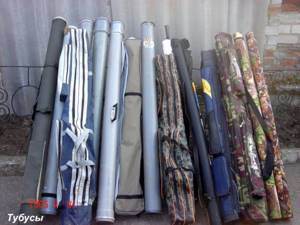
You can also equip the case with additional pockets in which you can store fishing lures. The pockets are sewn on top of the cover itself or Velcro is used, with which they will be attached to the tube itself.
How to make a handle?
If you want to equip your tube with a handle, then you need to attach it to the base of the pipe with bolts, this will be more reliable. The handle itself can be purchased at any bag store or tailor shop. If you equip the tube with a carrying handle, transportation of gear will be more convenient, especially since attaching the handle to the case is easy.
You need to drill several holes in the pipe for the bolts and use them to secure the handle itself, the length of which is selected individually.
Types of covers for fishing rods
Covers for fishing rods are divided into soft, semi-rigid and hard. The simplest fishing rod cover is made of soft fabric and protects fishing rods from dirt and water. It can hold 3-4 rods with or without reels. Also, in such cases it is convenient to transport racks and stands for fishing rods, landing nets, a small folding chair and a small sun umbrella.
In soft cases, fishing rods will not be protected from shocks and other mechanical damage. They can be used in cases where you manage to secure and place the cover in transport so that the likelihood of damage to the fishing rods is minimal. The height of such covers can be from 1 m to 180 cm. Short covers can accommodate folding telespins and floats and a landing net with stands. Longer ones can accommodate feeder rods and spinning rods. The advantage of such products is their low cost. More advanced models have a leather lining at the bottom. It increases the life of the product. Models without such a lining wear out faster, since there is constant contact of the rods with the bottom, and the bottom, in turn, often touches the ground.

Such products have the usual accessories: a simple shoulder strap and handles, regular locks with a zipper. There is a partition for fishing rods inside. They are sewn from polyester fabric that does not allow water to pass through. If you handle locks, belts and other elements carefully, they will serve you for more than one season. When purchasing such a cover for fishing rods, be sure to check the reliability of the locks and the quality of the seams in various places.
The second type is semi-hard cases. They are made from rigid polyester with the addition of leather and rubber. These models have several compartments that are closed with zippers. There are pockets of different sizes on the sides. They are convenient for storing various fishing and related accessories.
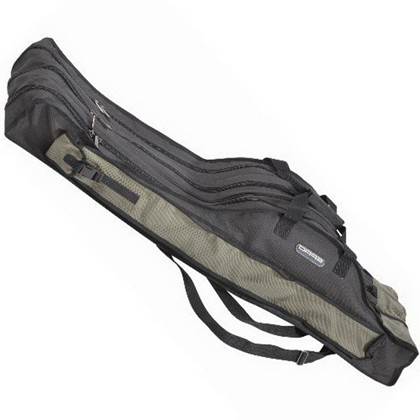
The shoulder straps of these cases are made of reliable material and have soft inserts that do not put any strain on your shoulders when carried.
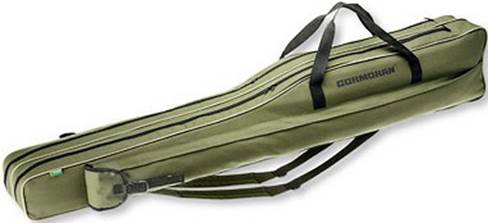
More expensive models have compartments for fishing rods inside. They are designed for carp rods. This is what they look like from the inside:
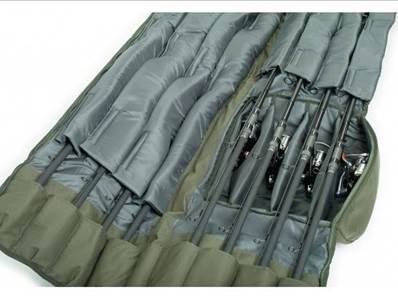
As you can see, inside the case there are compartments for reels and each rod is in a special compartment. With this placement, they will not touch each other and the likelihood of breakdowns will be minimized. Let us note the strength of the fabric from which these models are sewn. It can withstand heavy loads and after repeated use the fabric does not lose its properties and looks like new.
Such covers for rods can be purchased by both athletes and lovers of carp and bottom fishing. During long carp sessions it is often necessary to leave the covers out in the open air. During this time there is a large temperature difference and it may rain. Despite all these natural phenomena, the covers remain just as durable, functional and suitable for subsequent fishing trips.
Hard cases are best for keeping your fishing rods intact. They are also called coffers. Such models have a plastic frame that remains intact after falls. They do not allow moisture and water to pass through, and the rods will be absolutely safe during transportation.
The internal space is enough to accommodate up to 3-4 or more rods with or without reels. Some models are equipped with special stands that allow them to be placed in vertical or inclined positions:
For obvious reasons, the cost of hard cases is slightly higher than soft and semi-hard cases. However, if you have expensive rods and don't want the hassle of breaking them, then you're better off buying a hard rod case.
Store tube models
There are several models of fishing cases in the fishing store:
- hard;
- from soft materials;
- semi-rigid;
- tubes.
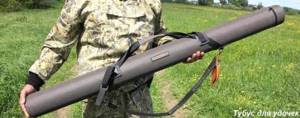
An economical option is simple soft cases made of waterproof fabric. However, tubes are considered the most popular accessory for storing and transporting fishing rods. They will not only protect your gear from moisture, but also protect it from mechanical damage.
Tube for spinning rods: is this thing necessary?
Professional fishermen have a whole arsenal of fishing equipment. We are talking not only about gear, but also about all kinds of accessories for storing and transporting precious devices. Firstly, they promote order and quick access to certain items, and secondly, they ensure the safety of equipment. This is of no small importance given the high cost of fishing products. Anyone who has ever experienced unexpected damage to gear will make every effort to prevent this from happening in the future. That’s why some people buy a case for a fishing rod, while others make a spinning rod tube with their own hands. The main thing is to achieve the goal and protect your favorite gear.
Preparing fishing rods for storage
To be prepared for the next fishing season, you need to properly complete the current one, namely, put in order and put away all the parts of the fishing equipment. These procedures will allow you to maintain the quality of the products, as well as be in full uniform for the long-awaited moment of the next fishing. Before placing the gear in a case for long-term storage, you should prepare it for this:
- All parts must be dried and cleaned. Depending on the degree of contamination, use warm water, detergent or a dry brush. Even slight dust or grains of sand can play a cruel joke on the rod and joints during the first fishing.
- The fishing line must not be stored under tension. It needs to be freed from hooks, weights, floats, removed from the reel, dried, and then loosely wound on a pre-prepared foam reel or reel.
- Make a thorough visual inspection of the spinning rods. If defects are detected, they must be corrected immediately.
Only after carrying out these simple procedures do you need to remove the spinning rods to a certain place.
Where to store spinning rods
It’s great when it is possible to allocate a separate room for storing fishing equipment. Do not forget that the environment should be cool and dry. Therefore, not every garage or balcony will provide favorable conditions. It is ideal to allocate a place for fishing rods in the house. A pantry or closet works well. Many people believe that fishing rods should be stored vertically on special racks. Others refute this opinion, claiming that this causes fishing rods to become deformed.
An alternative option for placing gear is tubes and covers for spinning rods. They have additional benefits:
- Compactly accommodates all gear;
- closed shape prevents dust contamination;
- do not require a special place, they can be placed on a shelf, under the bed, in the pantry;
- provide protection during transportation;
- you don’t need to collect fishing rods, look in different places, they are packed together - take the case and go.
The modern market offers a large selection of such products. If you don’t want to incur additional costs, you can make a rod tube with your own hands.
Types of cases for spinning rods
Transporting gear without proper protection is undesirable; it is too vulnerable. Moreover, this applies to both movement by car and public transport. For the safe delivery of fishing equipment to the reservoir and back, a variety of covers are used. These products can be divided into 3 types:
- Soft. These include fabric covers made from waterproof material. They protect fishing rods from various contaminants and high humidity, but are ineffective against mechanical damage. This is the most inexpensive placement option for spinning rods.
Photo 1. In original case.
Almost all models are equipped with a zipper, handles, shoulder straps, as well as pockets in which you can store removable parts and consumables. Many of them are designed for several fishing rods, which is very convenient. There are cases in which a spinning rod with a reel can be freely placed.
Tips for making your own tackle case
The first thing that is necessary is a clear definition of the desired type of cover. Here fishermen often start from:
- purpose of the case – storage, transportation, or all together;
- the way they get to the reservoir (on foot, by bicycle, by car, by public transport);
- type of gear placed.
Having answered these questions, it becomes clear what dimensions are optimal and acceptable - weight, size, shape. It is believed that it is worth making cases designed specifically for carp, spinning, plug and other equipment. However, most often they are universal. Thus, a tube for feeder gear is quite suitable for storing spinning gear.
General rules when developing a case model
You should not save when choosing a material; it should be:
Making a case yourself makes it possible to make it to the required size, usually the length is at least a meter. And in the case of a long rod, a homemade spinning tube can reach more than 2 meters. Its diameter should be such that your equipment fits. This is especially necessary for owners of models with large access rings on high legs to take into account.
Making your own fishing tackle case
Fabric cover
Sewing a fabric cover to the required dimensions can be ordered from a studio, or it can be done by your wife, a friend who knows how to use a sewing machine. There's nothing complicated about it. On the outside, it can be equipped with elongated pockets in which you can place stands, an umbrella, shore platforms, and a landing net. The main thing is to choose the optimal number of compartments; you shouldn’t overdo it with them.
Hard tube
How to make a spinning rod tube? Quite simple. The necessary spare parts can be easily found at any hardware store. Plastic sewer pipes or thick cardboard tubes are quite suitable for the housing. Here we select plugs of the required diameter, which will serve as covers for the tube. In order to prevent longitudinal impacts inside the housing, it is worthwhile to equip the covers on the inside with soft material. Foam rubber or a thick layer of felt is perfect.
Photo 2. Plastic sewer pipe - the base of the tube.
The outside of the case can be lined with a fabric cover and equipped with handles and shoulder straps for convenience. A do-it-yourself tube for winter fishing rods, as well as for feeders, is made according to a similar principle.
Photo 3. Tube in a case.
It doesn’t matter whether you purchase a ready-made case or create it yourself, the main thing is that it fulfills its function of protecting and organizing fishing gear.
